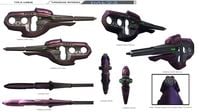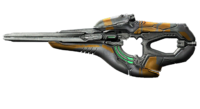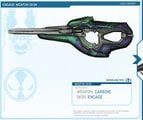Vostu-pattern carbine: Difference between revisions
From Halopedia, the Halo wiki
PatrickRus (talk | contribs) m (→Halo 4 skins) |
|||
| Line 154: | Line 154: | ||
===''Halo 4'' skins=== | ===''Halo 4'' skins=== | ||
<gallery> | <gallery> | ||
File:H4-CovenantCarbine-Skin.png|RGN(Reign) | File:H4-CovenantCarbine-Skin.png|RGN(Reign) Skin | ||
File:H4-T51CovenantCarbine-SteelSkin.png|LMV(Locomotive) Skin | File:H4-T51CovenantCarbine-SteelSkin.png|LMV(Locomotive) Skin | ||
File:Carbine Engage skin.jpg|ENG(Engage) Skin | File:Carbine Engage skin.jpg|ENG(Engage) Skin | ||
Revision as of 04:31, July 3, 2015
- "It’s almost a direct analog of the BR55. I just wish it had a more — um — conventional scope."
- — Anonymous serviceman
The Type-51 Carbine[1], also known as the Covenant Carbine, is a Covenant infantry firearm. Created and commonly used by the Sangheili, it is also carried by Kig-Yar and Jiralhanae.
Overview
The Type-51 Carbine was designed by the Iruiru Armory on Sanghelios, based on marksman rifles used earlier in the Sangheili's war-dominated history.[2] Although it may seem as an oddity as most Covenant technology is energy-based, the Covenant use several other solid projectile-based weapons.[3] The T51 is frequently used by Sangheili of various ranks, though its most prominent use is among Kig-Yar marksmen, who often utilize the weapon as an effective tool for sharpshooting and assassination.[1] After the Great Schism Jiralhanae infantry were often deployed with this weapon.[4] Though it was encountered as early as 2526[5] and was seen occasionally during the Human-Covenant War,[6] it was not properly cataloged by the Office of Naval Intelligence until 2551. This was likely due to the similar role and performance of the Type-31 Rifle, which was seemingly overshadowed by the Type-51 in the later years of the war.
Design details
The Type-51 Carbine is a recoil-operated and charger-fed, semi-automatic marksman rifle. It serves as medium to long-range weapon utilized by Covenant forces. The weapon's cylindrical magazine holds 18 rounds,[3][2] and also provides indication of number of rounds left in the magazine by utilizing a holographic display.[2] The back end of the weapon contains two circular openings, the forward one is the weapon's hand guard and the area in front of it is where the weapon's trigger is located. On the weapon's top rail is the magazine well and ammunition chamber,[2] next to it is a hammer like device which springs back when the weapon is fired. The forward part of the weapon contains the Type-51 Carbine's barrel, which controls the rapid acceleration of the projectile out at a high velocity.
Ammunition
The Type-51 Carbine marks itself as unique among Covenant firearms by its ammunition. Rather than using plasma bursts which can be inaccurate and slow at long range,[1] this weapon utilizes caseless radioactive projectiles, this ammunition can come in a number of compositions, but the Covenant primarily employ an extremely toxic compound mined from a radioactive moon in the Sangheili's star system,[2] as well as several other locations in Covenant territory.[7] The T-51 rifle can fire this projectile at supersonic speeds,[1] when fired, the round, which is coated in a shielded material[2] is accelerated to a speed anywhere from Mach 1 to Mach 5, traveling downrange at 2,296 feet per second.[2] The round is powered along its entire flight path, consuming up to 50% of its total mass by the time it reaches its maximum effective range.[3] The T-51 ballistic round can stop a target at up to six hundred and fifty yards.
Against light armored targets, the rounds' supersonic speed and super-heated nature ensures armor penetration on either the first or second impact. Impacts to the flesh can vary dependent upon range and speed - a single round impacting flesh at close range will penetrate deep into the target, and can nick bone. The kinetic energy from the impact of a round at close range can knock back an individual.[8] Two rounds that impact the same area at close range will pass through the target easily. Upon impact the round releases a toxic material into a victims bloodstream,[2] in addition to radiation burns the victim suffers. The chance of survivability of being hit from the T-51 rifle is low. If the round has not struck a vital organ the victim only has a few minutes before the toxic chemicals kill the victim unless it is treated immediately.[2] In most circumstances a surviving victim will require attentive treatment to ensure survivability.
Advantages
The Type-51 Carbine, with its 2x zoom ability is an excellent medium-ranged weapon; its accuracy and performance in the field makes it a up front choice for infantry who are required to engage enemy infantry:
- The Carbine can kill a standard-shielded enemy in seven rounds.
- The Carbine's rate of fire is faster than any known mid-long range semi-automatic weapons of its class.
- The Carbine can disable any type of infantry energy shield system including Jiralhanae Power Armor, Jackal Point Defense Gauntlets or Stationary Shield Generators.
- The Carbine's relative precision and low noise emission allows the carbine to perform multiple roles in the field; including designated marksman.
Disadvantages
The ballistic round gives off a light green trail, exposing the shooter's position, a weakness similar to the Type-50 Sniper Rifle System. Its distinct sound at close to medium range may also attract the attention of nearby enemies. The Type-51's firepower when compared with its UNSC counterpart the Battle Rifle, is stronger, yet slightly less accurate, especially if fired too fast. The magazine is also relativity small and when faced with shielded enemies, the player usually requires an entire clip to eliminate the target unless he/she aims at weak spots on the armor or energy shield systems.
Changes among games
Changes from Halo 2 to Halo 3
- In Halo 2, when the players uses the scope, the view is a group of seven hexagons melded into a honeycomb shape. In Halo 3, four lines will separate from the center in addition to the hexagons, almost on the same plane as the reticule lines.
- In Halo 3, the Carbine has a green patterned circle on top of the magazine indicator.
- Carbine ammo is much more abundant, double the amount usually given in Halo 2.
- Improved design, including more polygons and better textures.
- New sound effects for the carbine.
- The power has been reduced slightly from its Halo 2 counterpart. It now takes eight shots to kill a fully-shielded opponent in multiplayer, presuming the last shot is to the head, as opposed to seven shots in Halo 2.
- In addition to the reduction in per-shot damage, the Carbine also starts with two spare magazines when found in multiplayer, whereas it only started with a single spare magazine in Halo 2 multiplayer.
- Emits a small cloud of green gas and a soft hissing noise when reloading.
Changes from Halo 3 to Halo 4
- Many aesthetic changes to the weapon's overall structure, although maintaining the same iconic profile. Some notable aesthetic changes include the redesign of the stock to include two holes instead of three, and a purple color scheme instead of magenta.
- The ammo counter now resembles a radar display. The two circles located on the display have been changed to a single irregular hexagon.
- When zooming in, the color of the scope turns green instead of having no color like most other scoped weapons.
- When activating the scope, instead of the honeycomb shape seen in Halo 3, it has been changed to an oblong circular green shape.
- When inserting a new magazine, a panel flips up to allow access to the receiver, rather than pushing the magazine straight down.[9] This animation is similar to the way the needle rifle is reloaded in Halo: Reach.
- The reloading of the weapon also requires more user input, with the new magazine having to be forced in manually as opposed to having the top panel flip down automatically upon receiving the new munitions, as was evident in Halo 3. The empty magazine is also ejected with less force and does not fly straight towards the user as before.
- The weapon's reticule is now a dilated version of the needle rifle's reticule.
Changes from Halo 4 to Halo 2: Anniversary
- Retains the Halo 4 model.
- Lighting on weapon changed from green to light blue.
Halo Online
In Halo Online the T-51 carbine comes in several variants.
- The default carbine has a 18 round magazine and 72 rounds in maximum reserve ammo.
- The DMG carbine does more damage than the standard carbine at the cost of fire rate, accuracy, and and reduces the scope's zoom from 2x to 1.2x. It has a 9 round magazine and 18 rounds in maximum reserve ammo.
- The ROF carbine has a higher fire rate than the default carbine. It has a 20 round magazine and 40 rounds in maximum reserve ammo.
- The ACC carbine is more accurate than the standard carbine. It has a 9 round magazine and 81 rounds in maximum reserve ammo.
- The GOV carbine features a battery rather then a magazine. It can be fired 137 times, if fired at maximum fire rate for 7 seconds a 3 second cooldown will be triggered.
- The SNP carbine is more accurate than the standard carbine and features a variable-zoom scope similar to the Type-27 beam rifle. It has a 18 round magazine and 70 rounds in maximum reserve ammo.
- The golden carbine has superior stats all around. It has a 20 round magazine and 80 rounds in maximum reserve.
UNSC remarks
- “So — it’s just their projectile weapons that we’ve figured out how to reload? I guess I’m cool with that.”
- “It’s almost a direct analog of the BR55. I just wish it had a more — um — conventional scope.”
- “In my youth I used to board Olympus a couple o’ times a year—you see where I’m going with this? Yeah. That foxtrot gun is the size of my old board.”
- “Oh man! You really need to learn to recognize the symbols on top of the charger—and count your shots, too. First time I picked one up I just about brained myself when it ejected.”
- “Wish it was smaller; wish it had a proper stock—or at least a butt pad.”
- "Hey — don’t inhale immediately after the charger ejects. I heard that shit will give you Boren’s Syndrome." (There are no conclusive tests that indicate that the Type 51-Carbine put the user at risk for contracting Boren's syndrome.)

|
See our gameplay information related to Vostu-pattern carbine on its gameplay page. |

|
Browse more images in this article's gallery page. |
Trivia
- In the Halo 2 and Halo 3 instruction booklets, the Carbine is incorrectly labeled as having 36 rounds, instead of the actual 18 rounds. This is actually the number of rounds the Carbine's human equivalent, the Battle Rifle, has.
- In Halo 2, on the level Sacred Icon, there is a glitch where the player starts off with 78 spare rounds instead of the usual 72. However, if the player empties the magazine and then try and pick up Carbine ammo, the player will only be able to get a total of the usual 72 spare rounds.
- A number of Covenant Carbines have more spare ammo than normally allowed on the Halo 2 level Sacred Icon.
- On the Halo 2 campaign level Gravemind, several Carbines have 120 rounds in reserve, much more than the usual max, 72. This also occurs on other levels, especially if the Carbine is taken from an ally scripted to pick the weapon up, such as the Marines in the detention block in Gravemind.
- If the player gives a shield-bearing Jackal a Carbine in Halo 2 and then melee it, it will drop the Carbine and pull out a Plasma Pistol. This is done for the Unlimited Plasma Pistol Glitch.
- In Halo 2, when reloaded, the Covenant Carbine's magazine will pop out but disappear almost immediately. In Halo 3 they will fall on the floor and take a short while to disappear.
- In the Halo Wars official strategy guide, the Covenant Carbine is called a "slug beam rifle", probably because it fires radioactive rounds at rather high velocities and at long ranges.
- The designer's idea of the Type-51 self-ejecting the spent magazine might have come from the WWII-era M1 Garand's en-bloc clip.
- In Halo 3: ODST, the Carbine has a different firing sound, sounding much deeper than before. Also in Halo 3: ODST, if fired long enough, like the rest of the weapons, the reticle will start moving up. This is likely the result of the player character being an Orbital Drop Shock Trooper, instead of a SPARTAN-II or Sangheili.
- The Carbine is arguably the best non-power weapon available in ODST's Firefight mode. This is due to both the removal of the Battle Rifle from the game and the Carbine's status as a headshot-capable energy weapon, which makes its rounds immune to the adverse effects of the Tilt Skull.
- The Carbine seen in Halo 4: Forward Unto Dawn appears to be the Halo 3 iteration of the weapon, rather than the Halo 4 version. This is likely because it is probably the same prop that WETA Workshop created for Halo: Landfall.
- It is unknown why the Type-51 is designated as a carbine despite its length being greater than most Covenant "rifles" and its use as a marksman weapon.
Gallery
Normal Gallery
An early render of the Covenant Carbine for Halo 2.
A player attacks a Spartan with a carbine in the Halo 3 Beta.
A profile view of the Covenant Carbine from Halo 3.
- H3 Covenant Carbine angle.jpg
The Halo 3 Covenant Carbine.
Chyler Silva using a Type-51 Carbine at Corbulo Academy of Military Science in Halo 4: Forward Unto Dawn.
A first-person view of the Carbine in Halo 4.
The Master Chief wielding a Type-51 Carbine against a Sangheili Storm in Halo 4's campaign.
Aggressor Sentinels attacking a Hunter, as seen through the scope of a Type-51 Carbine wielded by the Master Chief.
Wielding a Type-51 Carbine in Halo 4's Spartan Ops.
John-117 using a T-51 Carbine in Halo 2 Anniversary<nowiki>'s campaign.
First-person view of the carbine in Halo 5: Guardians.
Smart scope with the carbine on Escape from ARC.
The T-51 carbine in Halo Online.
Halo 4 skins
Halo Online variants
The DMG carbine on Riverworld.
List of appearances
Sources
- ^ a b c d Halo Encyclopedia, page 322
- ^ a b c d e f g h i Cite error: Invalid
<ref>tag; no text was provided for refs namedEVG - ^ a b c Cite error: Invalid
<ref>tag; no text was provided for refs namedbung - ^ Halo 3
- ^ Halo 4: Forward Unto Dawn, Part 4
- ^ Halo Wars
- ^ Halo Waypoint: Catalog Interaction - Page 48
- ^ Halo: Evolutions Midnight in the Heart of Midlothian, page 90
- ^ Halo 4 News - Full Spartan Ops Match & Promethean EMP Grenade Gameplay
















































